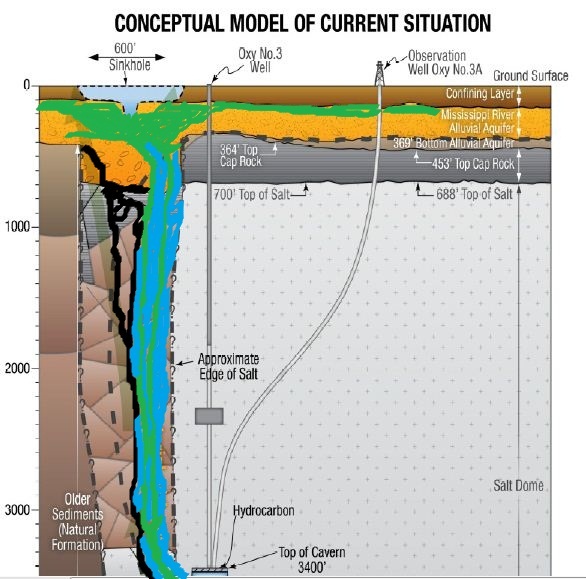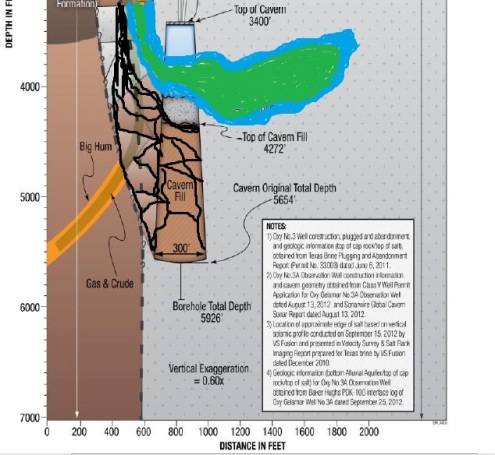http://lasinkhole.wordpress.com/2012/12/16/30-football-fields/
Sinkhole Expected to Grow to 30 Football Fields in Size
From The Advocate story on highway proposal . . .
“Scientists working for the Louisiana Office of Conservation and Shaw Environmental and Infrastructure have estimated the sinkhole could ultimately grow to 1,500 feet in diameter.
That’s an area covering more than 30 football fields, or about 40 acres.”
Texas Brine Lies About Cavern Integrity
Concerned Citizen sent this correction to Texas Brine’s spokeman Sonny Cranch flat statement – “We can state that during the 25-plus years of the life of this cavern, there was never any indication of a loss of integrity of the cavern,”
They had failed an MIT test on the cavern in 2011 and they all knew it.
and....
http://lasinkhole.wordpress.com/2012/12/15/lsu-geologists-weigh-in-on-sinkhole-cause/
LSU Geologists Weigh In on Sinkhole Cause
DECEMBER 15, 2012 BY FLYINGCUTTLEFISH
The Advocate - Company officials reject explanation of sinkhole’s formation
By David J. Mitchell
The sidewall of a Texas Brine Co. LLC salt cavern inside the Napoleonville Dome was dissolved through the dome’s outer edge, bringing the cavern into contact with surrounding sediment layers outside the dome before the cavern failed, an LSU geologist said Friday.
The assessment by Jeffrey Nunn, Ernest and Alice Neal professor of geology and geophysics and Pereboom professor of science, was a step beyond what other officials and scientists working on the sinkhole response have presented in public meetings and appeared to more closely lay the blame with Texas Brine, which mined the cavern by dissolving the salt.
Nunn spoke about factors leading to the sinkhole Friday during a luncheon talk at Mike Anderson’s restaurant to the Baton Rouge Geological Society. . . . .
http://theadvocate.com/home/4685215-125/geologist-details-failure-factors
“What this indicates is that the bottom part of this abandoned cavern completely dissolved away the salt and the cavern was in direct contact with whatever formation is in the area,” Nunn said.
The seismic data indicates that the western side of the dome has an overhang, or bulge on its upper side, where the salt edge goes out but then curves back inward and possibly intersects with the Texas Brine cavity, exposing it to outer sediments.
AND -
Nunn told geologists Friday that one of the scientists’ worst-case fears is that the salt dome could continue to break up from its western edge and threaten other underground caverns.
and....
LOUISIANA SINKHOLE NEW THEORY
Legend:
Blue-Fresh Water from Aquifer
Green-Brine
Black-Delineation of subsidence, rock, foreign materials, and Oil Migration.
Hello folks. I wanted to share an observation with you. I have now gone through all the pictures, flyovers, every scrap of information available, from Shaw, Texas Brine, and LDNR and one theme strikes out at me.
In every event, no matter whether it was a ‘burp’ or just trees falling in, you will notice that all the expelled trees and debris floats towards the edges, especially towards the dock of the Oxy 3 staging area.
Why is this important? Not because there is a rise in waters in an exchange of fluids.
Because it shows the high saline content around the rim of the sinkhole, as anyone knows a material floats better on waters with high salinity. In fresh water, they float for a bit, then sink to the bottom. So freshwater can only be towards the center of Lake Oxy 3.
What this shows is that fresh water is migrating and disappearing into the sinkhole and replaced with the briny waters from underneath while fresh water is sublimating.
There is an almost unlimited source of freshwater going down, express elevator style below the sinkhole funnel from the Mississippi River Alluvial Aquifer, and confirms to me anyhow, that the exchanges have sped up during this high water phase.
What is the result of this? Well, we don’t really know, but not hard to think the exchange continues in a revolving current until it reaches the rock salts. Once the fresh waters have absorbed all of the salts, then it is brined water and seeks a lower density, therefore returning to the top.
Also known as the “exchange”.
Conclusion: The fresh water will continue to eat all salts in the eastern edge of the salt cavern and the structural integrity has long ago been lost, and has expanded eastwards geometrically into the actual Salt Dome.
This is the cause of all the rock salt activity caught on the seismic monitors, as chunks of rock Salt continue to fall into an ever increasingly wide new cavern expanding daily. This phenomena is more prevalent during the day because of the heating of the waters of Lake Oxy 3 by the Sun, or solar radiation, and is the engine, or the power source for the continuing exchange current.
With every exchange current, the water fills more and more of the cavern inflow and outflow, and thus displaces all of the gases in the surrounding rock strata, and voids, forcing the gases and the oil of any of the shale and sand layers to find any path to the surface. I call it the “Big Squeeze”.
All of the bubbling is nothing more than a slow ‘Fracking process’. Unfortunately that makes the inevitable domal collapse a certainty in the future, as well, since all of the fractures created by these gases are undermining the areas where they are escaping, to the surface above.
If this theory is correct , then the Aquifer is full of not only methane, but oil and brine, methane, ethane, ethyl-chlorides, etc., etc., and has been lost.
Again, I state, this is only a theory, but fits the facts as we know them at this time.
http://theadvocate.com/news/ascension/4685215-123/geologist-details-failure-factors
Geologist details failure factors
Company officials reject explanation of sinkhole’s formation
The sidewall of a Texas Brine Co. LLC salt cavern inside the Napoleonville Dome was dissolved through the dome’s outer edge, bringing the cavern into contact with surrounding sediment layers outside the dome before the cavern failed, an LSU geologist said Friday.
The assessment by Jeffrey Nunn, Ernest and Alice Neal professor of geology and geophysics and Pereboom professor of science, was a step beyond what other officials and scientists working on the sinkhole response have presented in public meetings and appeared to more closely lay the blame with Texas Brine, which mined the cavern by dissolving the salt.
Nunn spoke about factors leading to the sinkhole Friday during a luncheon talk at Mike Anderson’s restaurant to the Baton Rouge Geological Society.
Other scientists have described the Texas Brine cavern’s sidewall as being close to the edge of the salt dome before the salt wall collapsed thousands of feet underground and allowed 3.3 million cubic yards of earth into the cavern. The failure of the cavern, which is inside but near the salt dome’s western edge, is believed to be the cause of a large sinkhole nearby and methane and crude oil releases in the area.
The sinkhole’s discovery on Aug. 3 between the Grand Bayou and Bayou Corne communities and south of La. 70 South prompted the evacuation of 150 homes in those two communities. The evacuation remains in effect.
Nunn, who has been speaking with a group of scientists working closely on the sinkhole, pointed to 3-D seismic imagery of the salt dome from 2007 to make his case.
“What this indicates is that the bottom part of this abandoned cavern completely dissolved away the salt and the cavern was in direct contact with whatever formation is in the area,” Nunn said.
The seismic data indicates that the western side of the dome has an overhang, or bulge on its upper side, where the salt edge goes out but then curves back inward and possibly intersects with the Texas Brine cavity, exposing it to outer sediments.
One suspicion of scientists working on the sinkhole has been that the overhang, which is above the Texas Brine cavern, collapsed as part of the cavern failure.
Nunn told geologists Friday that one of the scientists’ worst-case fears is that the salt dome could continue to break up from its western edge and threaten other underground caverns.
“We don’t know. That’s a worst case scenario. That’s simply an expressed concern,” he said in a later interview.
Describing what scientists fear, Nunn added: “ ‘OK, you know, this one cavern has collapsed, so is that going to have any impact on the adjacent caverns or not?’ ”
He noted that testing by operators on the dome have showed those other caverns have integrity. He said those tests probably settle those concerns in the short term, adding the fear is probably unlikely but more study is needed to be certain.
The Texas Brine cavern, like many others like it across the Gulf Coast, was hollowed out of a salt dome for brine production with what is called solution mining.
The process uses water to dissolve the salt and create a cavity. The remaining salt around the cavity creates walls, a floor and a roof that provide structural support.
The dome, a solid salt deposit that Nunn described Friday as an underground Mt. Everest, was thrust up over geologic time through overlying sediments.
The cavern had been plugged and abandoned by Texas Brine in June 2011 after an effort to test upper salt strata for mining, company officials have said, led to a compromise of the cavern’s surface access well.
Texas Brine officials disputed Nunn’s explanation of the cavern failure Friday, based on the company’s history with the brine cavern.
“We can state that during the 25-plus years of the life of this cavern, there was never any indication of a loss of integrity of the cavern,” Sonny Cranch, Texas Brine spokesman, said.
He added that Texas Brine never detected from the brine that the company was removing from the cavern that the company had gone through the salt face.
In a later email response to questions Friday, Patrick Courreges, spokesman for the Louisiana Department of Natural Resources, said officials are still studying the Texas Brine cavern failure.
“Analysis of the circumstances surrounding the failure of the Texas Brine cavern sidewall have not yet shown conclusively whether the company mined through the side of the salt dome,” Courreges, who attended Nunn’s talk, wrote.
“This analysis is continuing by experts involved, and information will be provided as it is learned.”

